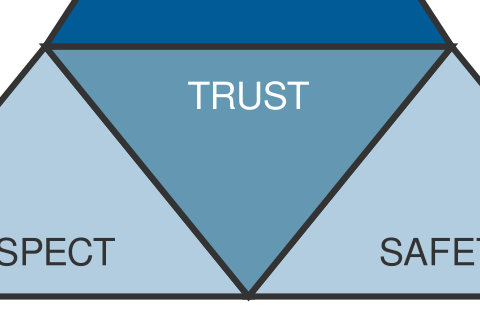Trust is the confidence a client places in you – confidence in your competence, your reliability, your integrity, and your commitment to their best interests. It sits on top of the foundation of Respect and Safety because a client can only trust you if they feel you consistently value them and provide a secure environment for interaction and decision-making.
For the client, Trust means feeling confident in your ability to:
- Do What You Say You Will Do (Reliability born from Respect for time & Safety through predictability): Consistently following through on commitments, no matter how small.
- Act in Their Best Interest (Integrity born from Safety through honesty & prioritizing them): Believing your advice and actions are genuinely aimed at helping them, not just closing a deal.
- Handle Complexity Effectively (Competence born from Respect for their challenge & Safety through clear process): Having faith in your ability to navigate their IT challenges and deliver practical, effective solutions.
- Communicate Honestly and Clearly (Transparency born from Safety & Respect for their understanding): Knowing you will keep them informed, explain things clearly, and be upfront about successes and challenges.
Here’s how to actively build and strengthen Trust:
1. Be Reliable and Follow Through (Solidifying Respect & Safety):
- Deliver on Promises: This is the cornerstone of trust. If you say you will call Tuesday, call Tuesday. If you promise a report by Friday, deliver it by Friday. This builds confidence in your dependability.
- Meet Deadlines: Consistently meeting agreed-upon timelines (or proactively communicating well in advance if a deadline needs to shift, explaining why) shows you respect their plans and can manage expectations reliably.

2. Demonstrate Competence Through Action (Leveraging “This is my Resume” & “This is Me”):
- Show, Don’t Just Tell: Instead of just stating your expertise, demonstrate it by providing insightful analysis, proposing practical solutions, or sharing relevant examples from your experience (like leading ERP migrations or optimizing critical functions).
- Solve Problems Effectively (Practical Solutions): When opportunities arise to offer solutions, ensure they are practical, well-thought-out, and address the client’s real needs. Your ability to find efficient paths (your natural efficiency) translates directly into competence they can trust.
- Acknowledge Limitations (Safety & Integrity): Trust is also built when you’re honest about what you don’t know or can’t do. If a request is outside your expertise, say so and perhaps suggest where they might find help. This integrity reinforces safety.
3. Communicate with Transparency and Clarity (Amplifying Safety & Respect):
- Keep Them Informed (“Inform Others”): Proactively update clients on progress, next steps, and any potential issues. Don’t wait for them to ask. Over-communication (within reason) builds confidence and reduces anxiety.
- Explain the “Why”: Don’t just state what you’re doing, explain why. This shows respect for their understanding and builds trust in your process and recommendations. Use language they can easily grasp.
- Handle Difficult Conversations Honestly: If something goes wrong, or there’s a challenge, address it directly, honestly, and professionally. Focus on solutions and lessons learned, not blame. This resilience and honesty are powerful trust builders.
4. Act Consistently and Predictably (Reinforcing Both Pillars):
- Be Consistent in Your Approach: Maintain the same level of respect, safety, and professionalism in every interaction. Inconsistency erodes trust.
- Align Actions with Words: Ensure that your behavior aligns with what you’ve said about your approach, your values, and your commitments.
5. Prioritize Their Interests Over Yours (Deepening Safety & Integrity):
- Offer Solutions That Truly Fit (Responsive & Intuitive): Because you wait to respond and trust your intuition (Sacral Authority), you are better positioned to recommend solutions that genuinely align with their needs and feel right, rather than pushing a pre-packaged offer. This authenticity builds deep trust.
- Advise Against Unsuitable Options: If a client is considering a path or solution that you honestly believe isn’t right for them (even if it means less work for you), advise them against it, explaining your reasoning respectfully and clearly. This demonstrates that their success is your priority.
Connecting to “This is Me”:
Your natural style is incredibly conducive to building trust:
- By Waiting to Respond and using your Intuition (Sacral Authority), you naturally engage with opportunities and propose solutions that are a genuine fit, building trust in your motives and judgment. You’re not forcing anything.
- Your drive to be Efficient and deliver Practical Solutions means you are built to deliver on promises, which is fundamental to reliability and competence trust.
- Your need to Inform Others translates directly into the transparency and clear communication required for predictable and honest interactions, crucial for trust.
- Your focus on Transformation and Value ensures that your efforts are genuinely aimed at their benefit, reinforcing the perception that you act in their best interest.
In short: Trust is the confidence earned through consistent, reliable behavior that upholds Respect and Safety. By listening intently, being transparent, delivering reliably, and prioritizing their true needs, you build the trust that allows a professional relationship to flourish.
If this post is resonating with you, keep reading — the posts below could help you take the next step.
Interpreting Client Reactions – The Unspoken Response
Understanding body language, facial expressions, and tone is a vital layer of communication. For you,…
Building a Trusted Partnership – A Consultative Flow
My approach to engaging with potential clients is inspired by the idea of structured steps,…
Interactive RSTC Presentation
RSTC Method Slide Deck Chief Cook and Bottle Washer Building Strong Client Partnerships: Respect, Safety,…
Building Strong Client Partnerships: The RSTC Method
Introduction: Building Our Special Client Tower! (3 min) Speaker Notes: Imagine we’re building a big,…
10 Skeptical, Challenging Questions
1.Introducing Myself to a Client Approach
This introduction blends your professional background with your natural, responsive, and practical approach, subtly laying…
